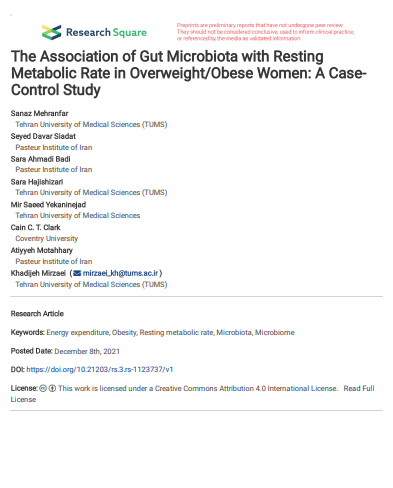Research square
Authors:
Sanaz Mehranfar, Seyed Davar Siadat, Sara Ahmadi Badi, Sara Hajishizari, Mir Saeed Yekaninejad, Cain CT Clark, Atiyyeh Motahhary, Khadijeh Mirzaei

Purpose
Low Resting Metabolic Rate (RMR), as a risk factor for obesity, can be affected by many factors. Indeed, genetic
and environmental factors are variables taken into account when predicting RMR, and may contribute to a high
inter-individual variance. Besides the well-known causes of obesity, researchers have demonstrated the
contribution of gut microflora in obesity and energy expenditure. Therefore, the goal of the current study was to
compare the Firmicutes/Bacteroidetes ratio and the relative abundance of, Prevotellaceae, Faecalibacterium
prausnitzii, bifidobactrium spp, lactobacillus spp, Akkermansia muciniphila, Bacteroides fragilis, and Escherichia
coli in two groups of people with normal and low RMR in overweigh/obese women in Iran.
Results
The abundance of F. prausnitzii (p>0.001), B. fragilis (P= 0.02), and Firmicutes phylum (P= 0.02) were significantly higher in the controls compared to the cases, and showed significant positive association with RMR, (β = 1.29 ×10, P=0.01), (β = 4.13 ×10, p= 0.04), and (β = 7.76 ×10 , p= 0.01), respectively. Regardin Lactobacilus, the results showed a significant positive association with RMR (β = 1.73 ×10 , p= 0.01).
Conclusion
Intestinal microbiota may be associated with host metabolism. Therefore, future work should investigate, using clinical trials, the impact of manipulating gut microflora to positively influence energy expenditure.